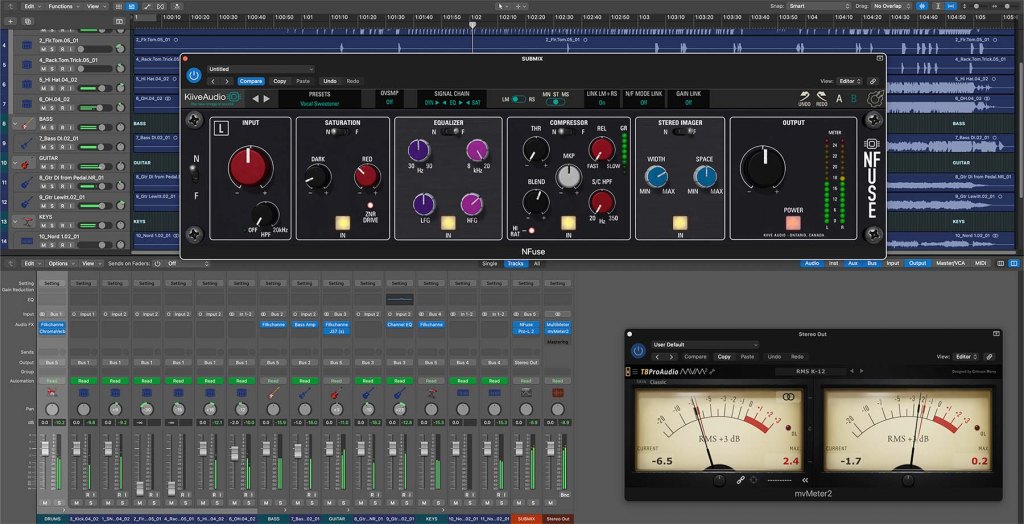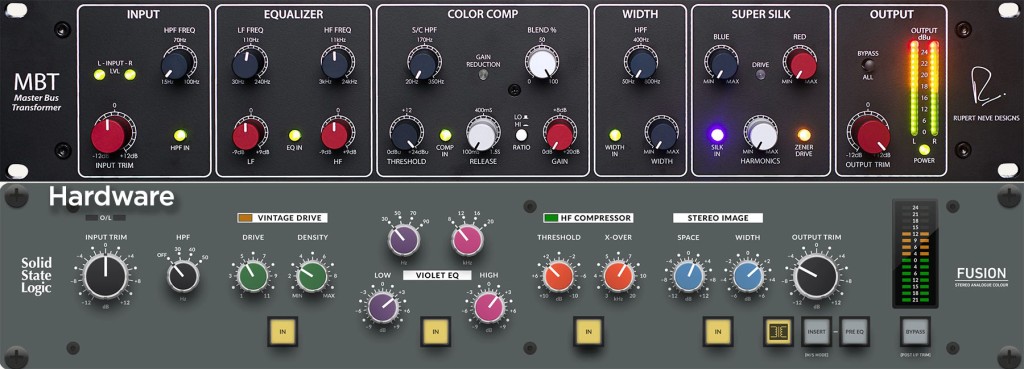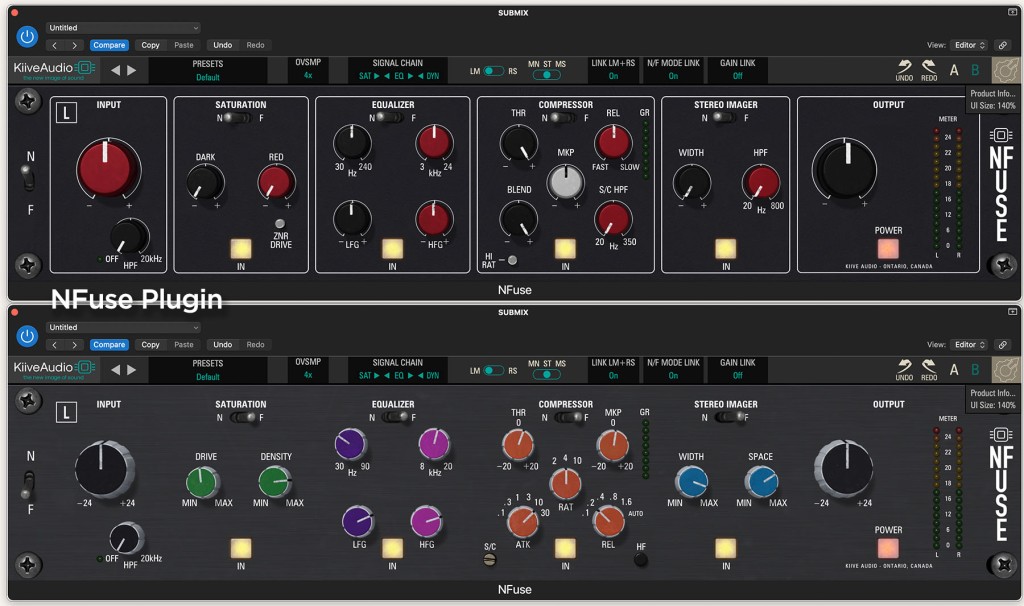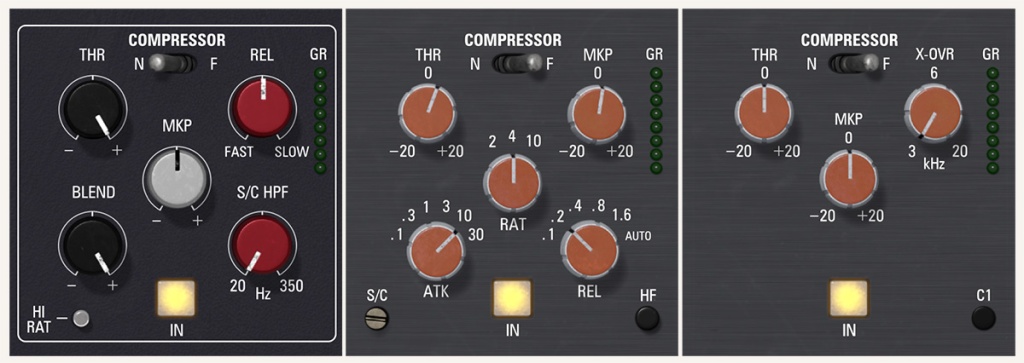
In the audio world there are frequent discussions around classic mixing desks – SSL, Neve, API, MCI, Harrison, etc. Most often the debate centers around Neve versus Solid Sate Logic (SSL). But modern mixes are more often than not done “in the box” using only DAW software and plugins. Many professional mixers augment this with outboard processing gear to impart that “warmth” and “color” of analog circuitry.
To service this market, both Neve and SSL offer stereo bus processors that combine EQ, compression, saturation, and stereo width components. That’s the Rupert Neve Designs MBT (Master Bus Transformer) and the SSL Fusion. Both offer more or less the same set of controls, but with their own, unique approach to curves, ratios, harmonics, etc. However, this comes at a steep price. The Neve MBT retails for $3,999 and the SSL Fusion for $2,199.
NFuse offers both in one plugin
Unless you are earn a solid income from mixing, then buying one of these, let alone both, doesn’t make a lot of sense. That’s where plugins enter the discussion. One of the newest is the NFuse bus processor from Kiive Audio. As the name implies, this plugin combines both the Neve MBT (“N”) and the SSL Fusion (“Fuse”) into a single unit. It features N/F toggles for the whole plugin, as well as each section, in order to easily switch between modes. If you like the Neve sound for several of these modules, but prefer SSL compression, simply toggle the compression module to the F setting. Of course, this would be impossible with the real hardware. Furthermore, since this is a plugin, you can add it to any and all channels, groups, and the master bus. With hardware you’d need to own multiple units in order to do that.
The basic components of NFuse are saturation, equalization, compression, and stereo imaging. Plus input and output levels. The small windows at the top of the interface let you set the oversampling amount, linking functions, as well as the processing order: sat>eq>comp, eq>com>sat, comp>eq>sat, etc. Stereo imaging is always the last module in this chain.
The Neve (N) and SSL (F) controls include slightly different features, just like the hardware. Since Kiive Audio has modeled these based upon the characteristics of each of these two hardware units, there are really two different “circuits” within the design of this plugin. For example, the high and low EQ ranges differ between the two, as do the compression ratios. Kiive recently added a new HF mode to the Fusion Compressor for a total of three compression types in all. Rounding things out, you’ve got a variety of factory presets, plus A and B saved states to easily compare two different settings.
Using NFuse for your mix
You can apply NFuse in various ways. For example, I mix music in Logic Pro, but video projects mostly in Premiere Pro. When working in Logic, I will group similar instruments into track stacks (summed groups), which are then routed to the main mix bus. Thus, combined groups for drums, bass, guitar, keys, and vocals are summed into the final mix. I usually apply a variety of processing effects to each instrument group, as well as the stereo mix bus. These are often third-party plugins, but could be a stack of native effects. The individual tracks get a smattering of native Logic plugins, as needed. Lastly, the master bus gets the final analog color and some compression.
With this approach, I could easily apply NFuse to each of the groups, along with the mix bus. After all, I can turn off some of the modules within the plugin if I don’t need them. However, a plugin that also works well for the groups is Filkchannel, another Kiive Audio plugin. That’s what I did in the test mix and then I applied NFuse to only the mix bus for the final “glue” to shape the mix. I like this approach, because all of the tools I need are in a single plugin interface, as opposed to stacking three or four different plugins when using native tools.
When it comes to my video mixes in Premiere, there’s little need for groups, since my timeline generally has fewer individual tracks. However, Premiere Pro doesn’t have a good multi-effect processor plugin that I feel like using. So instead, I’ll apply a combination of native effects. In this scenario, NFuse is also a good tool for a video editor.
The results
Naturally, the first question to ask is, “How does it sound?” Honestly, I’ve never worked with any of the hardware that this plugin was inspired by, so I can’t tell you how close it sounds to the hardware itself. However, there are plenty of YouTubers doing that, so you can make up your own mind. In most of the comparisons, hardware usually has a slight edge, especially when pushed. But given the price of the hardware, that slight difference is meaningless to most. Ultimately it’s all subjective.
In my mix, the plugin sounds very good. I realize the many people love the SSL sound, but to my ears, I find the various third-party SSL emulations, including NFuse’s “F” settings, to be on the aggressive side and can sound a bit harsh. Instead, I find myself gravitating to the Neve emulations, like 1073-style EQ plugins and so on. At least for my test mix, which was a jazz ensemble, the “N” modes of NFuse sounded smoother and more pleasing to me.
NFuse is a pretty close emulation to the hardware, however, because of that, there’s no limiter. Kiive Audio does market other plugins that do that, like the ADC1, which emulates hardware from Abbey Road Studios. In my case, I will typically apply a native Logic Pro or Premiere Pro limiter or sometimes Fabfilter’s Pro-L2 at the end of my mix bus chain. It would have been nice to include brick wall limiting as part of NFuse, even though that would have deviated from the original hardware.
Final thoughts
Kiive Audio retails NFuse for $199.99 (currently on sale as I post this) with a 14-day free trial. The price is attractive, but like any plugin, it’s worth checking out the trial before committing. The developer also offers licensing that’s easy to deal with. No iLok or cloud authorization required. My one quibble about NFuse is that the PDF manual needs to be a bit more detailed. It also doesn’t explain the newly-added HF Compressor mode. Maybe an update is just around the corner.
Overall, I liked the smooth sound NFuse delivered, especially in how it added character and glue to my final mix. That’s the sweet spot for me. Although you can use it on groups, I feel that other plugins like Filkchannel are better suited for those. NFuse offers a nice range of smooth to aggressive between the Neve and SSL-style emulations. This makes it ideal for various musical genres – especially when you just need that little something extra to enhance your mix.
©2024 Oliver Peters



